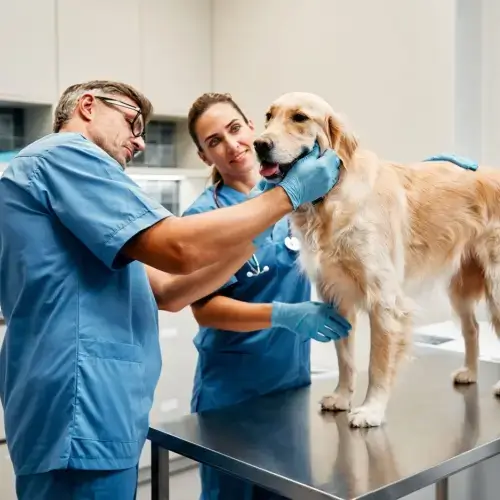Home / Compare Pet Insurance / Heatstroke in dogs
Heatstroke in dogs






Key takeaways
- Heatstroke occurs when a dog’s body temperature rises above normal levels and they aren’t able to cool down, which can lead to severe health consequences like organ failure or death.
- To prevent heatstroke, avoid leaving dogs in hot environmentslike cars and give them access to shade and fresh water at all times. They should also be exercised during cooler times of the day, such as in the morning or evening.
- When signs of heatstrokeappear, move the dog to a cooler area, hydrate it and seek veterinary attention immediately if the condition is severe.
What is heatstroke in dogs?
Heatstroke, known as hyperthermia, occurs when a dog’s body temperature rises above its normal range.1 Heatstroke is a life-threatening condition when a dog’s body overheats and cannot cool itself down effectively through its sweat glands. If not treated promptly, it can lead to organ failure, irreversible damage and even death.
Heatstroke may occur due to high temperatures, humid environments or physical exertion.2 It causes the dog’s internal temperature to rise rapidly, leading to serious health consequences. Understanding how to recognise, prevent and respond to heatstroke is essential for all dog owners.
Causes of heatstroke in dogs
Understanding the signs of heatstroke can help you avoid dangerous situations. Common causes include:2
- Hot environments: Leaving a dog in a car, poorly ventilated room or outdoor area without shade.
- Exercise in hot weather: Running, hiking or playing on a hot day.
- Inadequate water access: Dehydration accelerates overheating.
- Hot surfaces: Pavement, sand or artificial turf can amplify heat exposure.
- Poor ventilation: Being left in crates or carriers without proper airflow.
How quickly can heatstroke occur?
Heatstroke can develop alarmingly fast, depending on environmental conditions and the dog’s activity level.1 For example:
- Hot cars: Temperatures inside a car can rise by 20°C (36°F) within 10 minutes, even with cracked windows.
- High humidity: Humid conditions slow down evaporative cooling, accelerating overheating.
- Exercise: Intense activity in warm weather can cause heatstroke within 15–30 minutes.
Risk factors for heatstroke in dogs
 Some dogs breeds may be more at risk of heatstroke,, as are those with predisposing factors or certain physical characteristics and health conditions. These can include:1
Some dogs breeds may be more at risk of heatstroke,, as are those with predisposing factors or certain physical characteristics and health conditions. These can include:1
- Brachycephalic breeds: Flat-faced breeds like French Bulldogs, Boxers and Pugs may have narrow airways or laryngeal paralysis that limits their ability to cool down.
- Large or overweight dogs: Larger or obese dogs generate more heat during activity.
- Thick-coated dogs: Breeds like Huskies, Malamutes or Saint Bernards have dense coats that trap heat.
- Senior or young dogs: Puppies and elderly dogs have weaker temperature regulation mechanisms.
- Dogs with health conditions: Heart disease, respiratory problems or dehydration increase susceptibility.
Preventing heatstroke in dogs
- Provide cool areas: Ensure access to shade and cool water.
- Time activities wisely: Exercise during early morning or late evening when temperatures are cooler.
- Avoid risky situations: For example, never leave your dog in a car, even briefly.
- Use cooling products: Cooling mats, vests and fans can help lower your dog’s temperature.
- Monitor high-risk dogs: Be extra cautious with breeds or dogs prone to overheating.
Stages of heatstroke in dogs
Heatstroke develops in stages, progressing from mild symptoms to severe, life-threatening conditions. Recognising the symptoms of heatstroke can help pet owners administer first aid promptly and prevent complications.
The earlier you recognise the signs of heat-related illness and begin treatment, the higher the chances of recovery.1 Once a dog progresses to the severe or critical stage, the risk of long-term damage or death increases significantly.
Early stage: Heat stress
This is the first stage of overheating, where the dog’s body begins struggling to regulate its body heat.1
Signs:
- Excessive panting or rapid breathing3
- Mild drooling
- Restlessness or discomfort
- Seeking shade or cooler areas
- Slightly elevated heart rate.
What to do:
- Move the dog to a calm, shaded area immediately1
- Offer cool drinking water (not ice-cold water)
- Limit activity and monitor closely for signs of progression.
Intermediate stage: Heat exhaustion
The dog’s body temperature rises dangerously at this stage, and cooling mechanisms fail.1
Signs:
- Heavy panting, often accompanied by noisy or laboured breathing3
- Bright red gums and tongue
- Thick, sticky saliva
- Lethargy or weakness
- Vomiting or diarrhoea
- Increased drooling
- Elevated heart rate.
What to do:
- Start active cooling immediately by wetting the dog with cool water and using fans. This can help reduce blood flow, allowing heat to escape from the body.1
- Move the dog to an air-conditioned or shaded environment.
- Monitor the dog’s temperature (if possible).
- Contact your veterinarian to report symptoms and prepare for further intervention.
Severe stage: Heatstroke
At this stage, the dog’s internal temperature has risen above 41°C (106°F), leading to systemic failure. Heatstroke is a medical emergency.
Signs:
- Pale, blue, or grey gums due to oxygen deprivation3
- Collapsing or inability to stand
- Drop in blood pressure
- Confusion, dizziness or disorientation
- Seizures or tremors
- Loss of consciousness
- Vomiting or diarrhea (may contain blood)
- Weak or rapid pulse.
What to do:
- Act immediately to cool the dog down, such as spraying it with water or wiping its body with a wet towel, but avoid shock-inducing measures like ice baths.1
- Continue wetting the dog with cool water and using fans.
- Transport the dog to the nearest veterinarian or emergency clinic immediately.
Critical stage: Systemic failure
If untreated, severe cases of heatstroke can progress to organ failure and can result in death. Damage to the brain, heart, kidneys and gastrointestinal system becomes irreversible.
Signs:
- Unresponsive or comatose state3
- Irregular heartbeat
- Internal bleeding (e.g. bloody stool, vomiting)
- Multi-organ failure.
What to do:
- Immediate emergency veterinary intervention is essential.1
- Focus on stabilising the dog’s condition, which often requires advanced care like IV fluids, oxygen therapy and monitoring for complications.
Pet insurance for heatstroke
In Australia’s hot climate, heatstroke is a significant risk for pets and many pet insurance policies include cover for it under illness or emergency care plans. Comprehensive policies often cover costs such as veterinary consultations and diagnostic tests, as well as treatments like IV fluids, oxygen therapy and even hospitalisation. However, the level of cover available through pet insurance may vary between policies and exclusions can apply, particularly for pre-existing conditions or cases that were preventable, like leaving a dog in a hot car.
When choosing pet insurance, always compare and look for policies with sufficient annual limits to cover potential heatstroke-related costs, and check reimbursement rates to understand how much you’ll get back. Check the exclusions for breed-specific risks if you own a dog prone to heatstroke, such as brachycephalic or double-coated breeds.
Reading the Product Disclosure Statements (PDS) and Target Market Determination (TMD) to review the waiting periods, deductibles and claim processes will help you select the best plan for your pet and ensure that the policy fits your pet’s needs.
What happens at the vet?
 Veterinary treatment focuses on stabilising your dog and addressing complications, and includes:1
Veterinary treatment focuses on stabilising your dog and addressing complications, and includes:1
- IV fluids to combat dehydration and support organ function
- Oxygen therapy for breathing difficulties
- Monitoring for organ dysfunction, such as kidney failure or clotting disorders
- Blood tests to check for heat-induced damage.
Long-term effects of heatstroke
Even after surviving heatstroke, some dogs may experience long-term effects, including:1
- Sensitivity to heat, making them more prone to overheating
- Organ damage to the liver, kidneys or heart
- Neurological issues, such as seizures, muscle tremors or coordination problems.
Meet our pet insurance expert, Adrian Taylor
As a General Insurance expert with over 13 years’ experience in financial services, Adrian Taylor knows that dogs and cats get themselves into all sorts of mischief. One part of Adrian’s work is to help empower consumers to understand how pet insurance can help save them from exorbitant vet bills when their pet gets injured or falls ill.
Want to learn more about pet insurance?
1 Animal Emergency Service (AES). Heatstroke in dogs (what you need to know). Accessed January 2025.
2 RSPCA. The complete guide to heatstroke in cats and dogs. Causes, symptoms, prevention and treatment. Accessed January 2025.
3 petMD. Heatstroke in dogs: signs, treatment and prevention. Accessed January 2025.